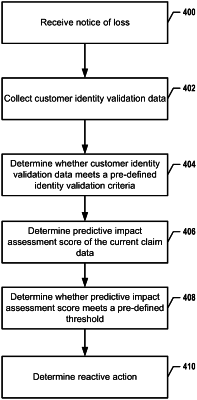| CPC G06Q 40/08 (2013.01) [G06N 5/048 (2013.01)] | 20 Claims |

|
8. A computer-implemented method, comprising:
responsive to receiving, by at least one processor and originating from a first computing device, a notice of loss associated with a claim of a user, collecting, by the at least one processor and originating from one or more external computing devices, customer identity validation data;
responsive to determining, by the at least one processor, that the customer identity validation data satisfies a first threshold, receiving, by the at least one processor, a first set of claim evaluation data originating from the first computing device and a second set of claim evaluation data from an Internet of Things (IoT) computing device;
generating, by the at least one processor and based at least in part on one or more trained machine learning models, a plurality of predictive impact assessment scores, each predictive impact assessment score associated with a unique intake field and associated response value of current claim evaluation data for the claim of the user, wherein each intake field of the current claim evaluation data comprises a response value associated with one or more of the first set of claim evaluation data or the second set of claim evaluation data;
responsive to determining, by the at least one processor and based at least in part on the plurality of predictive impact assessment scores associated with the current claim evaluation data, that an aggregated predictive impact assessment score satisfies an impact assessment threshold, activating, by the at least one processor and via one or more application programming interfaces (APIs) a claims scoping camera tool that is configured to overlay an augmented reality view interface on a screen display of the first user computing device;
applying, by the at least one processor, the one or more trained machine learning models to one or more captured images received via the claims scoping camera tool;
assigning, by the at least one processor and using an artificial intelligence (AI)-based image recognition software, a machine learning classifier providing an image subject description to the one or more captured images;
validating, by the at least one processor and according to a second threshold being met, each of the one or more captured images for fraud; and
responsive to validating, by the at least one processor, each of the one or more captured images for fraud, determining, by the at least one processor, a coverage for the claim using a coverage mapping for a set of policy data corresponding to an insurance policy of the user to identify a payment to the user.
|